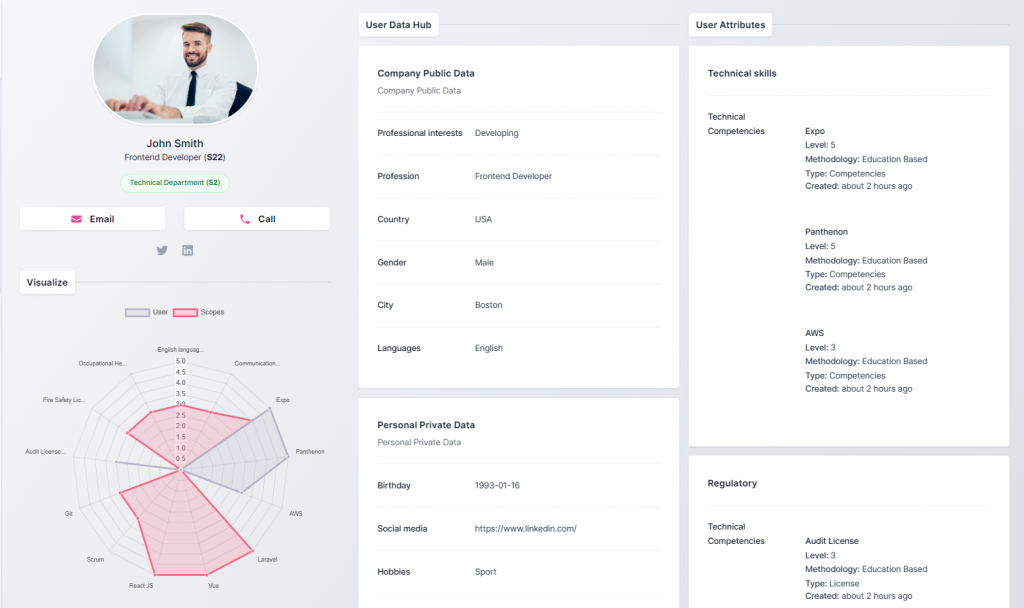In today’s fast-paced business environment, staying ahead means understanding what your workforce is capable of and where it needs to grow. Traditional performance reviews and spreadsheets can only take you so far. Enter the skills radar chart – a game changing tool that gives you a clear, visual representation of employee strengths, weaknesses and potential.
What is a skills radar chart?
A skills radar chart graphically displays an individual’s or team’s proficiency across a range of key skills. Think of it as a map where each spoke represents a different skill, and the plotted area shows current levels of competency.
This format makes it easy to spot:
- Gaps in skills that need immediate attention
- Overlooked strengths that can be leveraged more effectively
- Balanced skill sets for forming high-performing teams
Why traditional methods fall short?
According to a recent report by McKinsey (2023), 87% of executives acknowledge that their organizations have existing or impending skills gaps, but many struggle to pinpoint exactly where those gaps ares where a skills radar chart comes in – unlike manual spreadsheets or text-heavy reports, it provides a clear, actionable view of skills data, enabling faster decision-making.
Key benefits of using a skills radar chart
1. Clear visualization of competencies
No more wading through endless rows of numbers. A radar chart offers a snapshot view of where an individual or team excels and where they need improvement. This visual clarity means HR leaders can identify weak spots at a glance and start building targeted development plans.
2. Better workforce planning
With industries constantly evolving, workforce planning requires adaptability. A skills radar chart helps HR leaders plan for:
- Upskilling: Identify which skills need upgrading to meet future demands.
- Reskilling: Prepare employees for new roles within the organization.
- Succession planning: Ensure that leadership roles are backed by a robust talent pipeline.
In fact, a LinkedIn Learning Report (2023) found that 76% of HR professionals believe upskilling and reskilling are critical to closing talent gaps.
3. Analyzing employee development plans
Every employee is unique and so should their development plans be. With a skills radar chart, managers can craft personalized training paths based on each employee’s current competencies and career goals. This boosts engagement and retention, as employees feel their growth is being actively supported.
4. Enhancing team formation
Building high-performing teams is like assembling a puzzle – you need the right pieces to fit together. a skills radar chart allows managers to form balanced teams by:
- Ensuring a diverse mix of skills
- Avoiding skill redundancies
- Identifying complementary strengths among team members

How to implement skills radar charts in your organization?
Integrating a skills radar chart isn’t just about plotting data, but building a continuous feedback loop. Here’s a quick roadmap for successful implementation:
- Define key skills: Identify the critical competencies for each role.
- Assess current levels: Use performance data, peer reviews and self-assessments to gauge proficiency.
- Visualize & analyze: Create radar charts for individuals and teams to spot gaps and strengths.
- Take action: Develop personalized learning paths, promote high-potential employees and fill critical gaps.
A game-changer for strategic HR
Companies using visual tools like skills radar charts report 30% faster decision-making and 25% higher engagement in their workforce planning processes, according to a Gartner HR Report (2023). By enabling HR act quickly and precisely, radar charts help organizations stay competitive in a rapidly changing business landscape.

Ready to start mapping your organization’s skills and shaping your future workforce?
That’s exactly what we do at Brick, Mortar & Daughter. Our solution helps you visualize and manage skills data effortlessly, giving you the clarity and direction you need to build a future-ready organization. Not only can you track current attributes and skills levels, but you can also compare them to planned or desired levels. This feature allows managers to easily identify the most critical areas for development – highlighting where the gap between current and planned skills is the greatest. By focusing on these priorities, organizations can more efficiently direct their training and development efforts, ensuring faster growth and better results.



